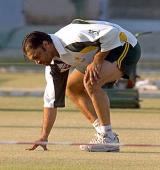If there's grass on the wicket ...
In the driest, dustiest, most arid destination on the tour, the flushest grass inhabits the pitch
Osman Samiuddin
27-Jan-2006
|
|

|
Will it stay or will it go? In the build-up to the final Test at Karachi that, in a nutshell, is the question. Shoaib Akhtar's left ankle is problematic, Inzamam's back even more so, but all eyes are only on the pitch at the National Stadium. Before the Faisalabad Test had even reached its irrelevant conclusion, rumours of a Karachi green-top had begun. Happily, the whispers are not unfounded; the pitch is liberally dressed in green. Ironically, in the driest, dustiest, most arid destination on the tour, the flushest grass inhabits the pitch. Whether it is there on Sunday, of course, is open to speculation.
Local curators say the grass will remain but might not be as plentiful on the day itself; but they mumble it with a wink and a nod. So will it be shaved off? "No, but it won't be as much as it is now. It will have to be evened out. But Inzi has still to see and he might have it cut..." In those three sentences lie a world of contradictions, intrigue and ambivalence, indicative of Pakistan's policy of preparing pitches for this series. Will it be cut? We don't know. How much will be cut off? We don't know. Might it be shaved off completely? Who knows?
Surrounding the pitch, this series, there has been the most absurd ambiguity. So heightened has the speculation been that the PCB were compelled to issue a statement clarifying their official stance on pitch preparation, claiming captain, coach and the management had unanimously asked for "hard, bouncy pitches" for this series. And before the statement, each time, Inzamam repeated only that he wants sporting pitches, as if cancelling out all those other statements where he has publicly called for flat, dead and uncompetitive pitches. Everyone else has backed him up. Yet, still Lahore and Faisalabad have produced pitches that were anything but sporting.
What, then, happened? The PCB has absolved itself of any blame for what happened, as well as the curators, who had to fight nature. But surely someone is responsible for the mess we find ourselves in? Inzamam's own policy towards pitch preparation is shrouded in vagueness. The queries in this series have been so frenzied that Inzamam publicly said he was the captain not the groundsman.
He says often that he only offers advice to groundsmen, but curators and even some PCB officials will privately admit it is more like the ominous `press advice' radical-ish editors received from various military governments for toning down criticism; low on advice, high on demand. He has history as well; at Multan two years ago, the most fantastic ruckus surrounded the baldness of the pitch and specifically whether Inzamam had asked Andy Atkinson, the English curator hired by the PCB for that series, to shave grass off the pitch just before the Test started. Inzamam denied it, Atkinson confirmed it.
But it doesn't necessarily reveal a defensive mindset either, especially in this series. Instead, it probably represents more a strategic miscalculation, an underestimation of basic Indian batting strength. The pitches against England were not a world away from what has been seen here. The weather has undoubtedly played a role but the difference has been exaggerated by the fact that against England, results were forthcoming. Increasingly, it seems that Pakistan thought they could bowl out India on similar pitches, like they had England. The plan overlooked, one, that India has a batting line-up still among the best in the game and two, they are likely to be more used to conditions here than the English were.
This blunder has now sprouted grass in Karachi. Amid all the criticism, it couldn't be any other way for such was the clamour, there just had to be grass. Photographers have laughingly taken pictures of the pitch already, as evidence if the grass is eventually shaved off. Only the length of the blades may now change.
As a concluding thought, one curator recalled the last Test at Karachi, against Sri Lanka, in October 2004. It turned out to be a fine contest; Abdul Razzaq took five wickets on the opening day, Younis Khan, Inzamam and Kumar Sangakkara scored hundreds, Danish Kaneria took seven second-innings wickets on the fourth day and Pakistan stumbled chasing only a low total before eventually sneaking through. The pitch as it now stands is "livelier than that one." Even if the grass is cut, it will remain, "a good one." After Lahore and Faisalabad, we'd be advised not to hold our breath.
Osman Samiuddin is Pakistan editor of Cricinfo